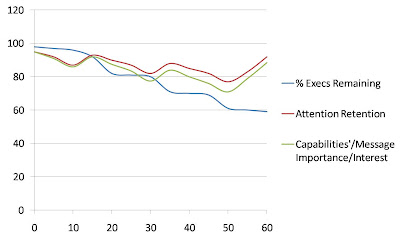
That looks much more reasonable...!
Tips, thoughts, tools, techniques and practices to increase success rates with software demonstrations

That looks much more reasonable...!
When I recommend, in Great Demo! Workshops, that you plan to “arrive” 15 minutes ahead of time for a Remote Demo, I often see a combination of confusion (in some people) and recognition (in others). I realized that a simple way to explain the idea is as follows:
For a face-to-face meeting, do you typically try to arrive 15 minutes early? If so, why? Most typically, Workshop participants respond:
- So that we’re not late…!
- So that we can set up and be prepared when the meeting starts [the right answer]…
- So that we can meet and mix with the audience [also a good answer]…
- So that we can meet with the principal(s) to make capture any changes in the plan, objectives, or participants [another good answer]…
For Remote Demos, why should this be any different?
In other words, treat your Remote Demo session (when possible) the same way you would a face-to-face demo and “arrive” at the meeting 15 minutes ahead of the formal starting time.
“Arriving” means coordinating with a customer Champion, Sponsor, or other key player – or a colleague at your organization who will be at the customer’s site – ahead of time, and setting the collaboration tool meeting (e.g., WebEx, Live Meeting, etc.) for 15 minutes ahead of the formal start.
That will give you time to ensure that the collaboration tool is working properly, that the audio is OK, and then to still have time to run through the other reasons listed above.
So, we can now agree –automated demos are critical for sales, and without a more strategic approach, online demos are only cherry-picking. Here are a few best practices you may want to consider when preparing the online automated demo.
These are but a few, albeit critical components to making the most out of automated demos. And keep in mind, they only become increasingly important as the entry cost lowers, and the audience widens (other languages, industries, business processes…). The one key fundamental rule to remember –demo to your audience and their specific needs – and let the demo do some selling.